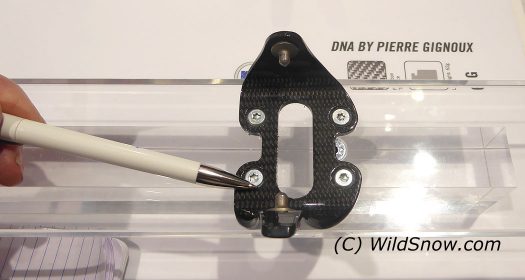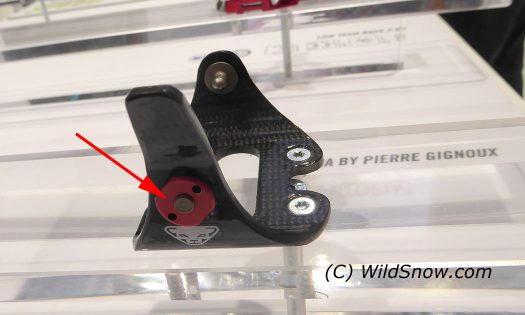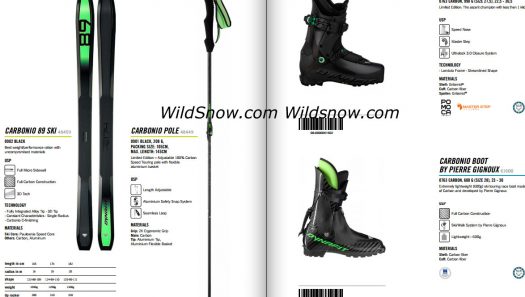Dynafit is doing the morph dance, that’s for sure. We began our coverage of the 2017-2018 some time ago, but ISPO is always a good bet for seeing the overall Dynafit product thrust. Their full-size booth reflects their corporate focus, while meeting with principles in the business such as product line managers and CEO Benedikt Bohm gives me the inside line.
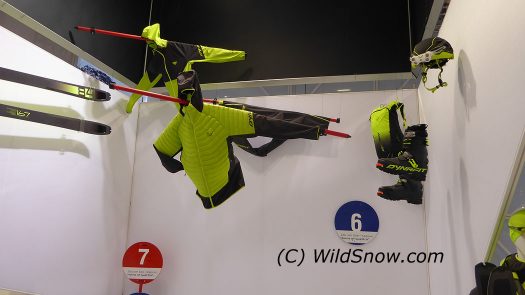
Speedfit line colors are nice, and this display caught my attention. But why did it catch my attention? I kept thinking those red rods hanging the clothing were ski race gates skewering the happy resort uphillers, alluding to the ever present extreme dangers of resort ski touring.
A principle of business is of course “grow or die.” A few years ago, Dynafit was looking for a numbers bump by introducing new products for freeride touring. I’m not sure that really worked. The timing was off. Too many other companies were introducing beef boots and then freeride pin bindings around the same time. More, it appears what freeriders really want is footwear that’s pretty much an alpine boot, and bindings that hedge much more in the alpine direction as well. Beast binding, now discontinued, probably tried too hard to remain a “Dynafit” touring binding, for example.
Whatever the case, while the (somewhat imaginary?) “freeride touring” segment had attention, something real was happening. Using light touring gear for climbing up and skiing down resort pistes underwent a surprising growth spurt.
Industry people are throwing around numbers such as “30% of people with ski touring setups, in Europe, rarely use their gear for the backcountry, instead they are piste touring.” From what I’ve seen in the U.S. I’m certain we’re right up there with the percentages as well. That’s amazing. No one saw it coming to that extent. Sure, we’ve been doing it ourselves for more than 30 years, but it was just a fringe sport, right?
So, look down your nose at these blasphemous individuals who claim to be “ski touring” resort slopes. But watch the ski industry respond.
More, just as ski mountaineering racing has stimulated the development of amazingly lightweight performance ski gear, look for piste touring to have its own form of influence. For example, resort uphillers are said to be very price conscious, and they like skis that perform on hardpack. Translation for backcountry skiers: more springtime touring skis that don’t cost a fortune.
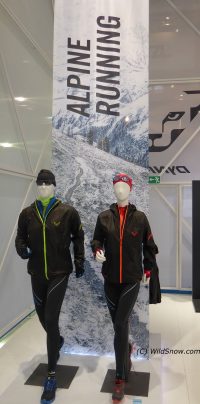
Dynafit continues to push their trail running clothing. This gear emphasizes running during the fall shoulder season, before skiing really begins but after temperatures drop and snowfall muds up the trail.
Dynafit’s 2017-2018 product categories are as follows (in my preferred order):
Race, Free, Speed, Tour. What is more, they’re pushing a new clothing category oriented to shoulder season trail running, not covered in this blog post but interesting nonetheless.
Race, for full skimo racing. Free for freeride touring using beef boots. Speed, for individuals who enjoy fast, lightweight touring with emphasis on efficiency. Tour, a bit heavier and more “conventional” boots For example the TLT 6 and 7 boots belong in the “Speed” groupo. Tour is a bit more traditional, mixing up and downhill, boot would be the Radical.
In my opinion the point of these categories, really, is to help shoppers make decisions about gear. Ostensibly the retailer quizzes you on what category you’re in, then starts recommending gear. Or you do your own ski touring psychoanalysis using the Dynafit diagnostic manual. Does this really help?
On the whole, the category system is probably moderately successful, but independent thinkers are clearly going to ignore what they’d call “stupid” categories and match their boots, bindings, and skis to their often unique skiing environment. Best example, in the powder lands of the American west, you constantly see riders with big fat skis sporting uber-light bindings driven by “Speed” boots such as TLT6.
I’m not convinced the “Tour” and “Speed” categories are different enough to be anything more than a marketing construct, as a well fitted TLT6 is still a tongue boot, as is a Dynafit Radical boot. On the other hand, getting back to piste “touring,” a subcategory of the Dynafit Speed category is “Speedfit.” That’s the stuff they’re pushing to the 30% who primarily ski up and down resorts. It makes sense to me.
My take on the Speedfit category products:
Speedfit 84 men’s and women’s skis are said to be designed with resort slopes in mind — “enjoyment” being the operative word. For example, The men’s 176 cm version is dimensioned at 116-85-104 with 21.5 meter radius, 1,350 grams. That indeed sounds like a fun ski, though slightly heavy for an uphill oriented ski in 85 mm waist width.
Speedfit boot appears to be quite nice, as well as unique in the Dynafit lineup (not just a colored clone of another model. In detail, it’s a TLT6-Mountain lower shoe and cuff, only with a fixed tongue rather than the faux tongue and swap-in tongue system of the TLT6. Buckles, lean lock and power strap are basically a TLT6. This is said to be a 1,200 gram boot in size 27.5, which sound on-target for the piste touring market.
Speedfit binding convinces me in the sense that it’s a “price point” product that’s about 25 grams heavier than its clone (the new TLT Speed binding) but more affordable. More in my previous Dynafit post from OR show.
Where I’m not convinced is why both these bindings would not have available spring swaps to change their vertical release, which is of a fixed value:
– TLT Speed, lateral release is adjustable 6-12, vertical release is fixed at 8.
– TLT Speedfit, lateral release adjustable 5-10, vertical release is fixed at 6.
When so many other bindings are available that either have full lateral and vertical release adjustments, or else available swap springs, this seems like a hard sell for a ski shop. As in “oh, you usually ski your bindings at 7 for vertical release? Well, you have to ski the Speedfit at 6, or the Speed at 8. Take your pick!”
Conclusions: I continue to admire Dynafit for their efforts in figuring out the ski touring market. They experiment with categories, and put their money where their mouths are by retailing products specific to those categories. Some of it appears forced, but the Speedfit category is a good one.
Bonus thoughts:
I helicoptered over the binding table, guided by binding product manager Michael Zimmermann. With something like 16 different binding models (depending on how you count), it’s not exactly easy to sort this all out in your mind. Helps to just forget about the Race category?
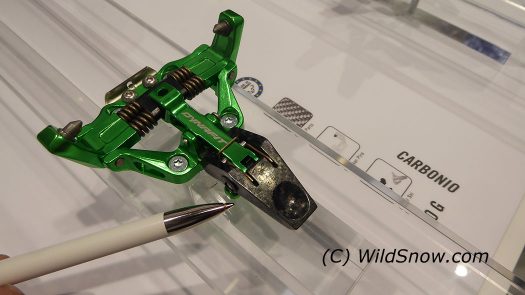
Carbonio version of the Superlite 2 confuses the binding table, but perhaps it works for retailers. Carbon parts such as the touring lock lever save 4 or 5 grams.
But wait, I thought one of the most interesting things on the table was the improved DNA (Pierre Gignoux) binding. It has a new hole pattern for the toe, matching the 4-hole “Radical” Dynafit binding pattern. Lighter by 62 grams, with adjustable toe pin tension so you can tune entry and exit. Fixed release values, let’s just call them “high.”
Someone asked about the Carbonio Dynafit product category. Despite the name, in my view this stuff is more about it being an attractive black color scheme that attempts to differentiate on looks, and being sold only in “limited edition for special dealers.” Nonetheless the Carbonio ski goes wider to an 89 waisted plank at catalog weight of 1200 grams for the 174 cm length, and the boot goes to a version of the new TLT7 that a few grams lighter to easily fall into the “1 kilo” category. The ski could be quite interesting. Image below is from the 2017-2018 catalog.
And…. someone asked what brands use the Dynafit certified tech fittings as of now. Here you go:
·Scarpa
·Arcteryx
·Fischer
·Salomon
·Crispi
·Roxa
·Scott
·Tecnica
·Lange
·Nordica
·Movement
·Hagan
·Atomic
WildSnow.com publisher emeritus and founder Lou (Louis Dawson) has a 50+ years career in climbing, backcountry skiing and ski mountaineering. He was the first person in history to ski down all 54 Colorado 14,000-foot peaks, has authored numerous books about about backcountry skiing, and has skied from the summit of Denali in Alaska, North America’s highest mountain.

